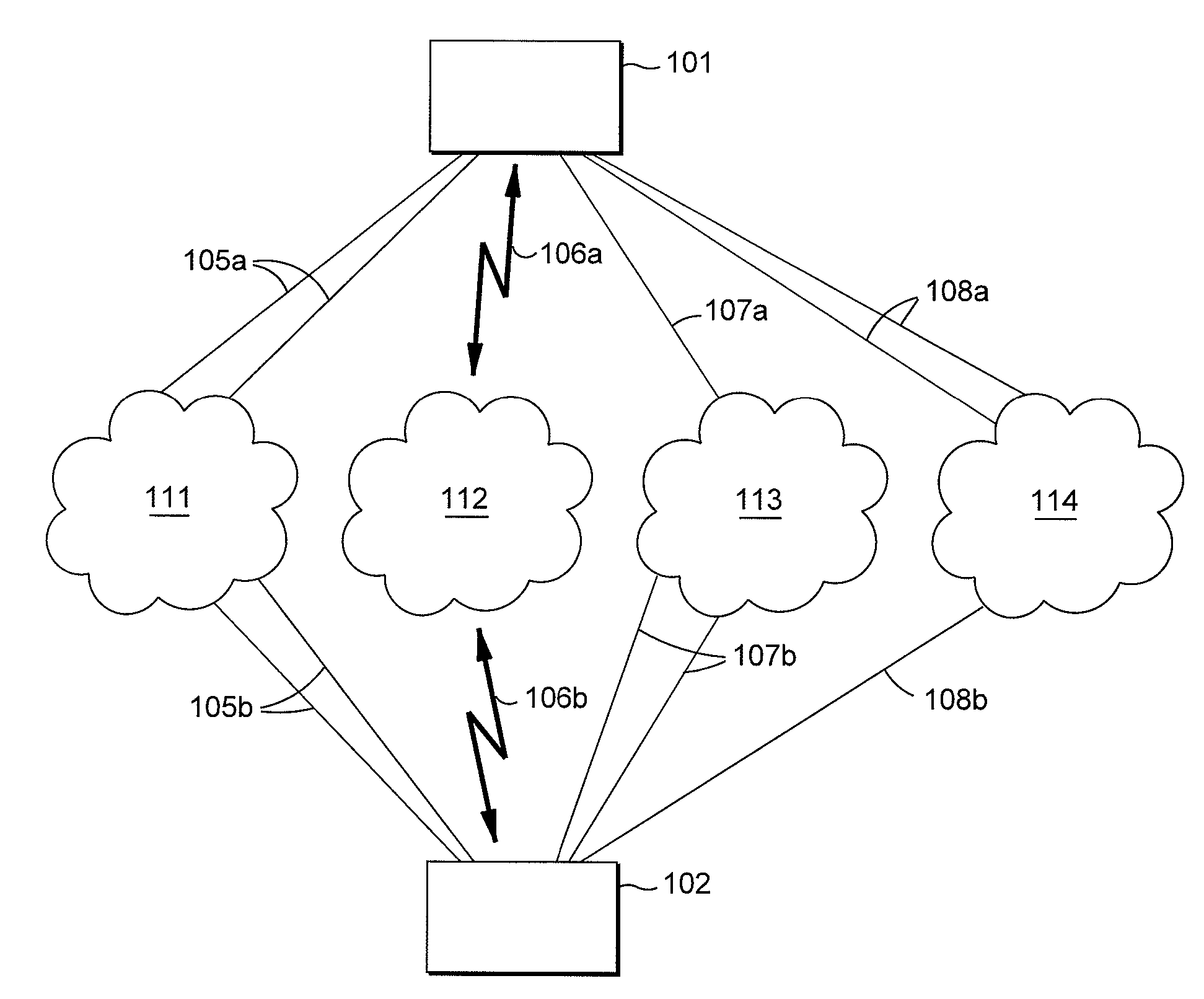[0006]With such an architecture, the single
data stream is split into sub-streams and sent over multiple physical interfaces which connect the endpoints of the network, instead of
streaming data over only one of the possible physical interfaces. This solution is more flexible and resilient to network load or impairments because multiple physical interfaces are used simultaneously.
[0012]By virtue of the foregoing arrangement, it is ordinarily possible to ensure that data packets of a data
stream are received at a receiving endpoint on time and in approximate order, which in turn minimizes any unnecessary
processing requirements at the receiving endpoint of a network. In this regard, the receiving endpoint may be, for example, a typical
set top box,
digital video recorder (DVR), or other
consumer device such as a
consumer device intended for use with a TV. When compared with a typical desktop computer,
laptop computer, or home
server, the typical devices for a receiving endpoint are resource constrained having drastically less
processing power, reduced memory, and smaller
mass storage. However, the typical devices for the receiving endpoint will be tasked with, for example, receiving one or more streams of
multimedia content, viewing and / or recording content from a cable or
satellite TV provider, acting as an input / aggregation device for collecting pictures or uploading personal video content,
purchasing and / or playing music, etc. In addition, in the above described arrangement of sending a single
stream of data over multiple physical interfaces, the receiving endpoint carries the additional burden of temporarily storing an unknown amount of data, and then reassembling the resulting data
stream. Therefore, because data packets are extracted out of order from further back in the series, and these extra data packets are sent over slower ones of the multiple physical interfaces so as to arrive in an approximate order of the
original data stream, any unnecessary buffering and / or
processing being performed by the receiving endpoint is minimized, which greatly reduces the load on an already overburdened receiving endpoint.
[0013]In another aspect of the disclosure, the sending endpoint and the receiving endpoint each have a single
physical interface connected to each of the multiple networks. When sending the next available data packet of the series over a fastest one of the multiple physical interfaces, a send-side
physical interface is selected from one of the single physical interfaces connected to one of the multiple networks. The selected send-side physical interface being the fastest single physical interface of the sending endpoint in accordance with the determined expected difference in
arrival time. In addition, a receive-side physical interface is selected, the selected receive-side physical interface being the physical interface of the receiving endpoint connected to a same network as the selected send-side physical interface. When sending the extracted data packet of the series over a corresponding slower one of the multiple physical interfaces, a send-side physical interface is selected from one of the single physical interfaces connected to one of the multiple networks. The selected send-side physical interface is a slower corresponding single physical interface of the sending endpoint in accordance with the determined expected difference in
arrival time. In addition, a receive-side physical interface is selected, the selected receive-side physical interface being the physical interface of the receiving endpoint connected to a same network as the selected send-side physical interface. Because the sending endpoint and the receiving endpoint each have a single physical interface connected to each of the multiple networks, the processing power, necessary for designating a send-side physical interface and a receive-side physical interface for each data packet, is reduced.
[0025]In yet another aspect, if ones of the extracted data packets sent over corresponding slower ones of the multiple physical interfaces continue to be delayed, then the receiving endpoint communicates an added expected difference in arrival time to the sending endpoint for the delayed ones of the extracted data packets. Furthermore, if ones of the extracted data packets sent over corresponding slower ones of the multiple physical interfaces are received at the receiving endpoint earlier than the next available data packets sent over the fastest one of the multiple physical interfaces, then the receiving endpoint communicates a reduced expected difference in arrival time to the sending endpoint for the early ones of the extracted data packets.
[0026]In an additional aspect, the receiving endpoint maintains a history of the multiple physical interfaces on which ones of the extracted data packets continue to be delayed, and ones of the extracted data packets which arrive early. Based on this maintained history, the receiving endpoint creates a
predictability model to more accurately predict future expected differences in arrival times. Because the receiving point can accurately predict future expected differences in arrival time using the
predictability model, any unnecessary oscillation of communications from the receiving endpoint can be prevented. More precisely, a
scenario can be prevented in which the receiving endpoint communicates an addition to the expected difference in arrival time, communicates a reduction in the expected difference in arrival time, and then again communicates an addition to the expected arrival time.
 Login to View More
Login to View More  Login to View More
Login to View More 


